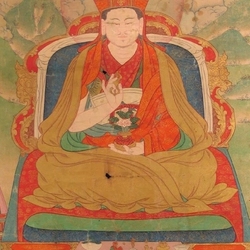Advice for Tashi Lhamo
from The Essential Amrita of Profound Meaning: Oral Instructions and Practical Advice Bestowed Upon Fortunate Followers, Eye-opener to What is to be Adopted and Abandoned
by Chokgyur Lingpa
Faithful Tashi Lhamo (Auspicious Goddess), if you want to attain awakening,
consider how hard it is to win this human body, with its freedoms and riches.
Your life may be long, but it’s as fleeting as last night’s dream.
Even though you’ve reached ninety, still you prepare to live on!
If you don’t keep in mind impermanence and death,
you can call it Dharma practice, but it will only be scraps of advice.
Mountain dwellers, spiritual vagabonds, and the like—
none of them, these days, have any skill in applying the teachings.
If your intentions are good and you sound the maṇi horn,1
then even as a householder you can easily attain buddhahood.
Generally, to encounter the Dharma is extremely hard,
but actually to meet a master who teaches Secret Mantra?
That’s the impossible made possible!
Nowadays, to be a true practitioner of Secret Mantra,
there’s no other way but to apply this single practice:
know all thoughts as the dharmakāya!
This is the essential pith instruction of the Great Perfection and Great Seal.
In an instant, all five poisons are freed in their own place.
If you realize this, it is impossible to keep wandering in samsara.
And if you combine this with the excellent intention of bodhicitta,
even samsaric activities will become the Dharma.
If you request oral instructions but fail to practice them,
it’s like listening to a folk singer’s rambling tunes.
The most profound oral instructions are the Buddha’s Word,
yet these days they pile up in basements like so much family junk.
It’s not that there’s no one explaining the Dharma,
it’s that there’s no one listening to the vital meaning with all their heart.
What’s the use, then, of laying out the Dharma, like market wares?
“I’ll practice the Dharma later!” they say. Such a lie!
So, whatever it is you’re doing, exert yourself in Dharma.
There’s always enough free time to recite the maṇi.
If you keep to your mala, you’ll recite and reap benefit.
If you forget your mala, you’ll forget to recite the maṇi.
So keep to your mala always, for there’s value
from the imprints created by the maṇi’s repetition.
Some say, “What’s the benefit of reciting mantra without meditation?”
They don’t know that simply recalling Avalokiteśvara from time to time is enough.
If you’ve obtained all the empowerments of the peaceful and wrathful deities,
and you squint at the sun or a butter lamp’s light,
the orbs that appear are your own intrinsic awareness.
They come from nowhere else but your own heart’s center.
Merely recognize this and you’ll be liberated in the bardo for sure.
Know it as the light of the ever-excellent kāya, Samantabhadra’s wisdom form.
If you train, step-by-step, the kāyas and pure realms will arise.
This is a pith instruction for attaining awakening in a single life.
When the guru who grants you mind teachings
is able to turn your mind to the Dharma,
they are your true root guru.
Constant devotion to them is essential.
If your samaya degenerates, you’ll have veered from the path.
So always be careful to keep your samaya pure.
If you accomplish whatever the guru commands, you’ll maintain pure samaya.
Even if you don’t practice, pure samaya will be enough.
The emissary of all the buddhas is the guru.
By connecting with them, you’ve connected with all the buddhas.
When you please the guru, all the buddhas are pleased.
The victorious one’s compassionate embrace is vital!
There are those, of course, who don’t benefit your mind.
Though they’ve a high throne, they aren’t your root guru.
Though they show great kindness, they aren’t your root guru.
Though you may be very close, they aren’t your root guru.
So, know how to recognize your root guru!
While going to build the temple at Kela Norbu Phünsum,2
at the request of Tashi Lhamo,
the realized one, Chokgyur Zhikpo Lingpa,
the slightly crazed man whose delusion has collapsed,
spoke this in common verse, easy to understand,
in the temple of Tsalapön.
It was then hastily written down by Mati Ratna.3
May all who encounter it be born in the realm of sambhogakāya, the body of perfect enjoyment!
| Lhasey Lotsawa Translations, 2021.
Bibliography
Source text
- mChog gyur gling pa, “rJes ’jug skal bzang rnams la bstal pa’i zhal gdams bslab bya nyams len gyi skor spang blang mig ’byed zab don snying gi bdud rtsi.” In mChog gling bka’ ’bum skor. Vol. 36 of mChog gling bde chen zhig po gling pa yi zab gter yid bzhin nor bu’i mdzod chen po, 87-88. Kathmandu, Nepal: Ka-nying Shedrub Ling monastery, 2004.
-
(Tib. ma Ni dung) A call to witness when one hundred million maṇi mantras have been recited. It is a phrase particular to this Tibetan tradition. ↩︎
-
This is the place that was to become the seat of Tsikey Chokling Rinpoche, at the site of Norbu Pünsum, where Chokgyur Lingpa revealed the Guru’s Heart Practice: The Spontaneous Fulfiller of Wishes (Tukdrup Sampa Lhündrup, Tib. thugs sgrub bsam pa lhun grub). ↩︎
-
That is Karmé Khenpo Rinchen Dargyé. ↩︎

